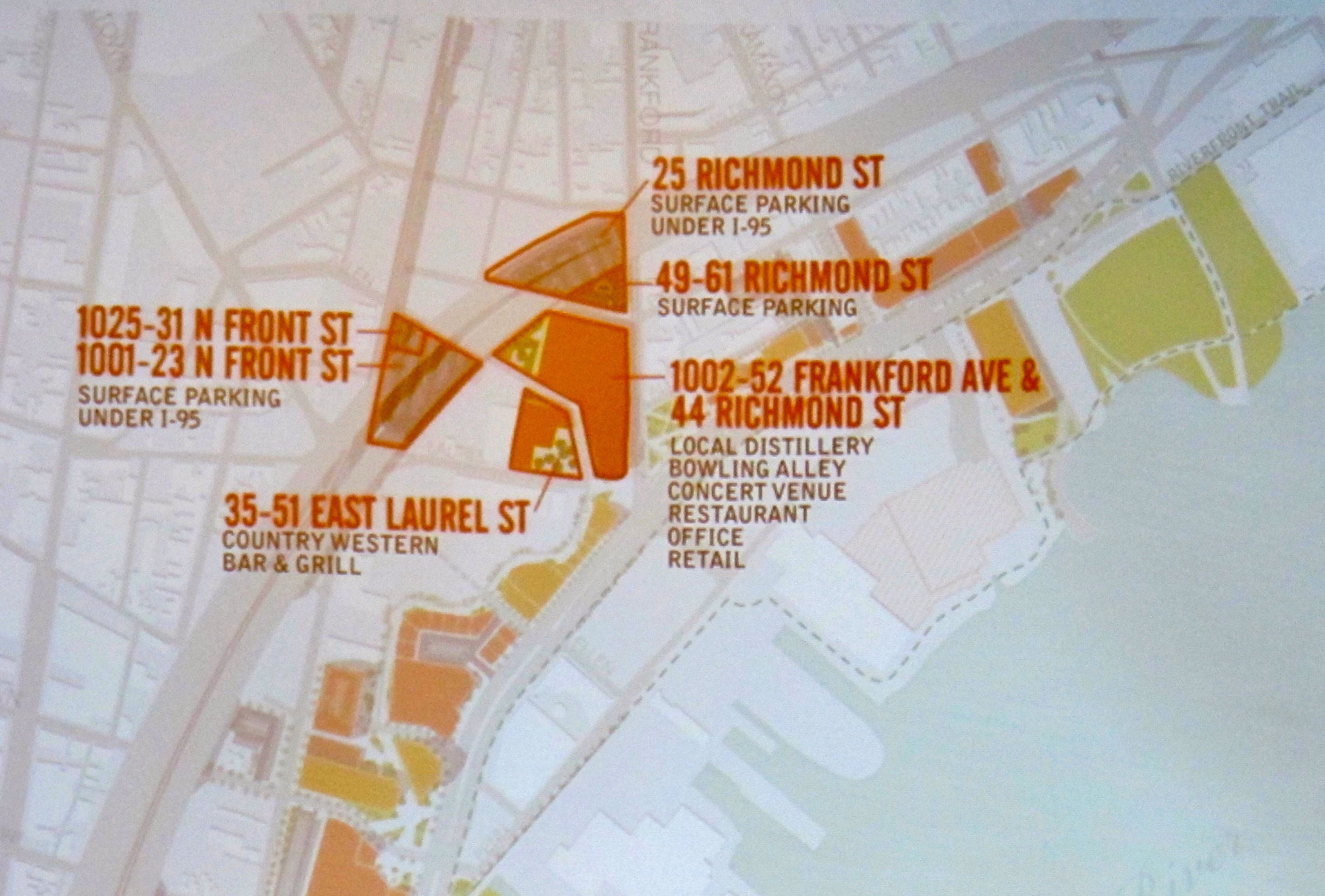Core Realty presents plan to re-use the former Ajax Metal Works building as a music venue, bowling alley and restaurant

Philadelphia planning commissioners and Fishtown residents seemingly have similar, mostly fond feelings about Core Realty’s proposed development for the former Ajax Metal Works and dry ice building.
They like the plan to bring new use to these old, vacant buildings across from SugarHouse Casino – Fishtown residents voted 86 to 25 in favor of the proposal earlier this month – but do have concerns about parking and billboards.
The plans for the Ajax building include a 3,000-person music venue, a bowling alley, a restaurant and a working distillery with tasting room, said Scott Page, an urban designer with Interface Studio who presented Core’s plan. The dry ice building, located across Allen Street, would house a country-western bar and grill. The project would include a 13,000 square foot public green space near the Ajax building and 337 parking spaces, located beneath highway overpasses.
The project is called Canal Street North at Penn Treaty Village. Core owns blocks of properties along Delaware Avenue, and Canal Street North fits into a greater master plan for the entire area. The multi-block, mixed-use development is called Penn Treaty Village.
The master plan imagines, over the long term, “ a mix of uses with repurposed buildings, family friendly entertainment and a unique pedestrian experience along Canal Street,” Page said.
Another portion of Penn Treaty Village includes two apartment buildings called the Pennthouses at Penn Treaty Village. Built from former auto storage buildings at Brown Street, one is open and construction has begun on the other, Core Realty’s Michael Samschick told commissioners.
Commission Chairman Alan Greenberger spoke of what a nifty place small, winding Canal Street is. He asked if Core imagined it being a pedestrians-only street. That is a long-term goal, Page said, but not part of this first phase.
The Canal Street North project is under three different zoning overlays, Page, said: The Central Delaware Waterfront Overlay, the North Delaware Avenue Neighborhood Commercial Overlay and the North Delaware Parking Overlay. The Central Delaware Overlay requires planning commission approval on a project plan of development. The North Delaware Neighborhood Overlay prohibits entertainment uses, and relief would be needed. Because restaurants are part of the mix, the parking overlay boosts the parking requirement to 675 spaces.
“Our take is 337 spaces are adequate” because a trolley runs on Frankford Avenue and the Girard Avenue El stop is also close by, Page said.
He said finding the right amount of parking is a balancing act, between providing enough for the development without creating a “sea of parking.”
Fishtown Neighbors Association zoning chair Matt Karp said residents are “really excited about the adaptive re-use of these buildings, especially the Ajax building,” but are concerned that the parking is not adequate, and that residents will still chose to search for free spots in the neighborhood.
Commissioner Nancy Rogo-Trainer said despite the nearby presence of public transportation, she believes most people will drive to events at the venue. She suggested Core bring a detailed plan for overflow parking when they return seeking board approval, and suggested that maybe businesses could use a parking validation system where patrons could park for free with a stamped ticket.
Commissioner Beth Miller asked if some patrons couldn’t park in the SugarHouse lot. The trouble with that, Greenberger noted, is that the proposed entertainment uses of Canal Street North would be busiest and require the most parking at night – just like SugarHouse.
The two billboards are accessory uses, Page said, meaning they will advertise things that are on-site. They both face I-95, and are “a required part of the lease” that Core is working on with future tenants.
Rogo-Trainer said she would like to see more details about accessory vs. non-accessory uses and what is really needed to go forward.
Greenberger noted his excitement over the ideas for both the adaptive re-use of buildings and new construction. “We understand that you can’t do it all at once,” he said, but he advised the development team to show commissioners that there is commitment to the plan for the larger area, and to put this portion of the development in that context.
When asked when construction on the Canal Street North project would begin, Samschick said he won’t make that determination until the planning commission decides whether or not to support the project plan. He said he plans to bring the matter back to the commission next month.
Core’s architecture firm on the project is Woodcock Design. Principal Janice Woodcock, who was present but did not speak at the meeting, is a former Planning Commission executive director.
Reach the reporter at kgates@planphilly.com.
WHYY is your source for fact-based, in-depth journalism and information. As a nonprofit organization, we rely on financial support from readers like you. Please give today.



